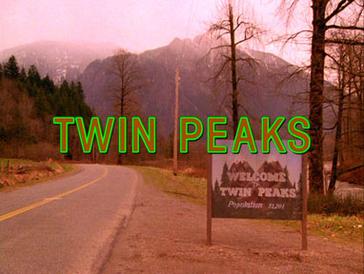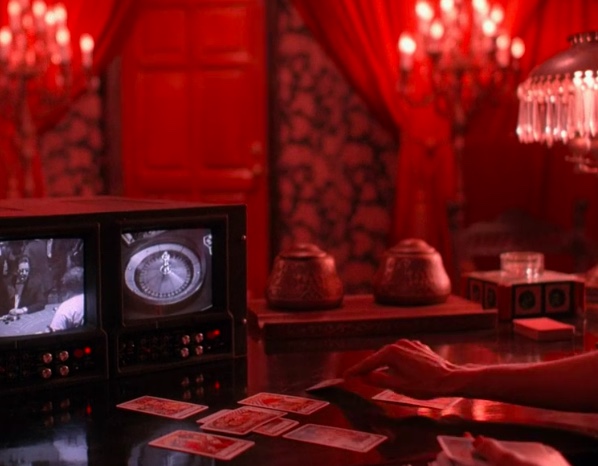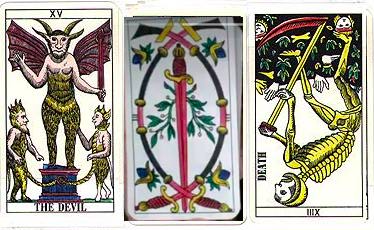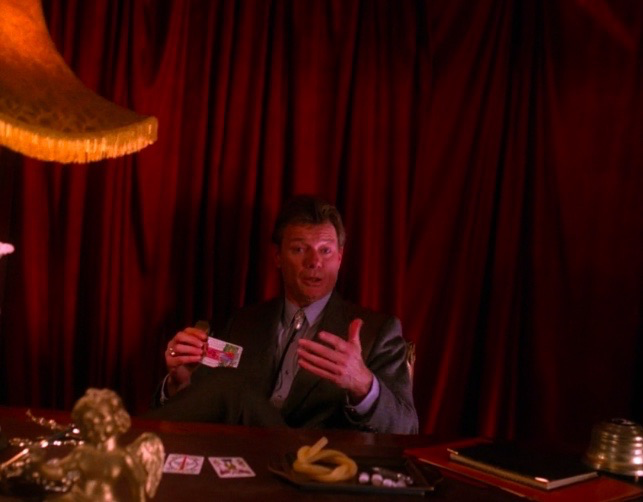
[THE USUAL DISCLAIMER: These are notes and drafts, not a completed work. As such, I have not worried too much about the academic niceties of form, and everything I write is subject to change, and people are welcome to make suggestions or criticisms. In fact, I’m hoping that you do. –Kitos]
Usually when Tarot cards make an appearance in movies, they are laid out without any rhyme or reason. Or you’ll see them in a scene in which someone draws a single card and throws it dramatically face up on the table. And—gasp!—it’s DEATH or THE LOVERS or something a Tarot-naive audience can make sense of without foreknowledge. Twin Peaks is a television series which aired on CBS in the United States between 1990 and 1991, the creation of Mark Frost and David Lynch. Twin Peaks shows some sophistication about the actual use of tarot. For example, the American villain Blackie has a Rider-Waite-Smith clone deck and the layout she uses is the Celtic Cross. That kind of deck and spread are in fact most popular among Americans and British.

By contrast, the French Canadian Québécois villain Jean Renault (who just happens to be in the midst of a tarot reading when we first meet him) is using a French Marseille deck in a the three-card spread, both more common in the Francophone world.

Clearly someone involved in setting up these scenes knew at least that much about Tarot culture. Now to look at the cards to see if they seemed to be deployed with any significance. We are somewhat limited in making this evaluation, as there are only a few shots where the cards are visible and identifiable.
First Season: Episode 8
When we first see the tarot cards, they are presented in the same shot as the television monitors for the casino, obviously to establish their identical purpose: surveillance. Blackie O’Reilly, the madame-manager of the One Eyed Jacks Club in Canada, is in her office laying out cards in what is clearly the traditional Celtic Cross arrangement. The King of Pentacles is clearly visible in the “What Crown You” (or Conscious Influences) position at the top of the cross. The deck O’Reilly is using is the Hansen-Roberts Tarot, by the way.


Blackie O’Reilly is the #2 in command of this moneymaking operation, working under Benjamin Horne, the richest man in Twin Peak, so it is easy to see how the King of Pentacles in this position would be relevant. King Benjamin Horne is what crowns Blackie.
And precisely when O’Reilly is in the act of laying a card in Position 8, or the What-You-Need-To-Know-About-The-People-Around-You, the door in the background opens and in comes her new hire, reporting for inspection.
And what Blackie really Needs To Know About Her, but doesn’t, is that this woman is actually Audrey, on a secret mission of her own, and the daughter of the club’s owner, Benjamin Horne. Unfortunately, it’s impossible to tell which card Blackie has just laid in Position 8.
[Two Asides, before I move on to the other tarot deck we see in this series. If you like, you can skip over these asides to get to the other Tarot deck in Twin Peaks.
1. The Lesbian Innuendo of the 52-Card Deck
After looking her over, Blackie tells Audrey to pick out a card from a standard 52-card deck (spread out face up), and Audrey picks out the Queen of Diamonds. What’s the point of having someone pick out a card from a deck face up? Is the Queen of Diamonds is obviously meant to represent Blackie herself, as the Club-cum-Brothel-cum-Casino’s Queen (Diamonds equate to Pentacles) and Second-in-Command under Pentacle King Benjamin Horne.

After Audrey deliberately chooses this card, she and Blackie make prolonged eye-contact, Blackie puts her hand on Audrey’s, and we hear some cliched sexy music. Blackie has made a lesbian overture, and Audrey has signaled interest. (Later in the series, we will see Audrey, as if branded, wearing a Queen of Diamonds on her sexy clothing.)
The details of this exchange are interesting to note.
When Blackie spreads out the deck with the cards face up, we see the cards in partial order: nothing but straight-flush runs of five or more cards. The Queen of Diamonds violates this pattern: she is all by itself between straights of spades and clubs. This can only mean that Blackie had deliberately positioned the card in the deck.
The visual pun is that the Queen doesn’t belong to the straight crowd.
Even though the Queen’s index number is only partially visible, it stands out as the only red card by itself, and Audrey picks it out right away. Did Audrey realize what the overture was and so signal her acceptance of it?
I also note, by the by, that the only other card that is by itself and not part of a suit sequence is the top card Blackie’s hand is covering when she fans out the deck, and it is another Queen: the Queen of Spades. So, true to her name, Blackie’s also a very dark queen.
It’s striking that we have a scene with both tarot cards and an ordinary poker deck at work in it. Since one of the primary themes of Twin Peaks is the juxtaposition of the ordinary with the mystical, perhaps this is being expressed in this scene by the juxtapositioning of an ordinary 52 -card poker deck and the Tarot.
Second Aside:. Other Peripheral Tarot Symbolism
When I first saw this scene, I wondered whether or not the roulette wheel in the second monitor was another Tarot reference (The Wheel of Fortune, obviously). The roulette wheel calls attention to itself, since is odd for the monitor’s camera to be aimed at the wheel itself and not at the table. And that in turn led me to wonder whether the figure in the first monitor, FBI Agent Dale Cooper was meant to suggest the First Arcanum, the Magician. Cooper is visible from the waist up before a table (like the magician) table and making a fortune with his usual aplomb and luck. He is even depicted at the same angle as the Marseille Magician always is. The fact that he’s wearing a tuxedo is also evocative of a stage magician. (Remember, the traditional Tarot magician is more like a stage performer than a magus. Cooper is a bit of both.)

So, subsequently I found out that someone had designed a Tarot deck featuring characters from TWIN PEAKS in the Major Arcanum. It turns out that the character used for the Magician card is, in fact, Special Agent Dale Cooper.

I don’t know much else about the deck besides this. It may be a splendid deck, but it makes it difficult to do internet research on tarot in Twin Peaks, since since virtually every internet search I try connecting Lynch with Tarot just turns up references to this Tarot deck.]
Now, on to the other Tarot deck in Twin Peaks. ]
Jean Renault’s Tarot
(Episode 4 of Season 2, also known as Episode 12)
Jean Renault is one of those villains whose veneer of elegance makes him all the more frightening. As noted above, he’s using a Marseille tarot.

It looks to me like the deck Jean Renault is using is the 1974 U.S. Games CLASSIC TAROT, which is a reproduction of the 1751 Claude Burdel deck. I was only able to tell after seeing this shot of the cards in a different scene.

The giveaway is the card with that red object on it. Can you make it out? Here, I’ll invert the image.

It’s the lightening-struck tower of Arcanum XVI. The only deck I know with a red tower belongs to a deck in the Marseille genus: the U.S. Game 1974 TAROT CLASSIC, a reproduction predicated on the 1905 Schaffhausen Tarot. (Although the publisher of the TAROT CLASSIC, Kaplan, says the deck is based on the 1751 Burdel, it bears far more similarities with the Schaffhausen.)

As for the spread itself. The cards he has drawn are the Devil, the Three of Swords (inverted), and Death (inverted).


We might start off by noting that, if nothing else, this at least shows an awareness that inversions in Tarot have meaning.
Is this spread relevant to the dramatic situation? Well, let’s consider this. The dramatic context is that Audrey, being held captive to work as a prostitute subsequently has had a heroin habit forced on her to render her more helpless. Since she has been refusing to have sex with clients, Emory Battis, her “manager” has dragged her to Jean to sort her out. But Audrey tells Jean that Emory has struck her for her non-cooperation. Jean finds this unacceptable promises Audrey that nobody will ever hit her again. By way of reassurance, Jean then shoots Emory dead right in front of her.
So, you’ve got the Devil card, associated with bondage and imprisonment. The Three of Swords (inverted) is associated with sorrows of some sort. It is sometimes said to represent the resolution of a conflict with coworkers (!). Or, one could get visual about it à la readers like Camelia Elias and see the card as a heroin needle being plunged downward into Audrey’s arm. But however you take the Three of Swords, the inverted Death card is not hard to work into the reading in some way. Is it the imminent murder of Emory—a murder which ostensibly is committed to reassure Audrey but is probably intended more to intimidate her? An evil sophisticate like Jean Renault might relish a double-entendre like that.
Obviously Jean’s reassurances are meant to seem hollow and insidious. As if to drive this point home, when he’s trying to reassure Audrey, he inadvertently keeps flashing the Maison Dieu (Tower) card at her.

Later, when we see Jean and Blackie together, the Death card is visible on the counter as they discuss killing Audrey.

But in actuality Jean is preparing to kill Blackie herself. As if to conceal his intentions, he places his glass on top of the Death card.

To be continued…
[THE USUAL DISCLAIMER: These are notes and drafts, not completed works. As such, I have not worried too much about the academic niceties of form, and everything I write is subject to change, and people are welcome to make suggestions or criticisms. In fact, I’m hoping that you do. –Kitos]